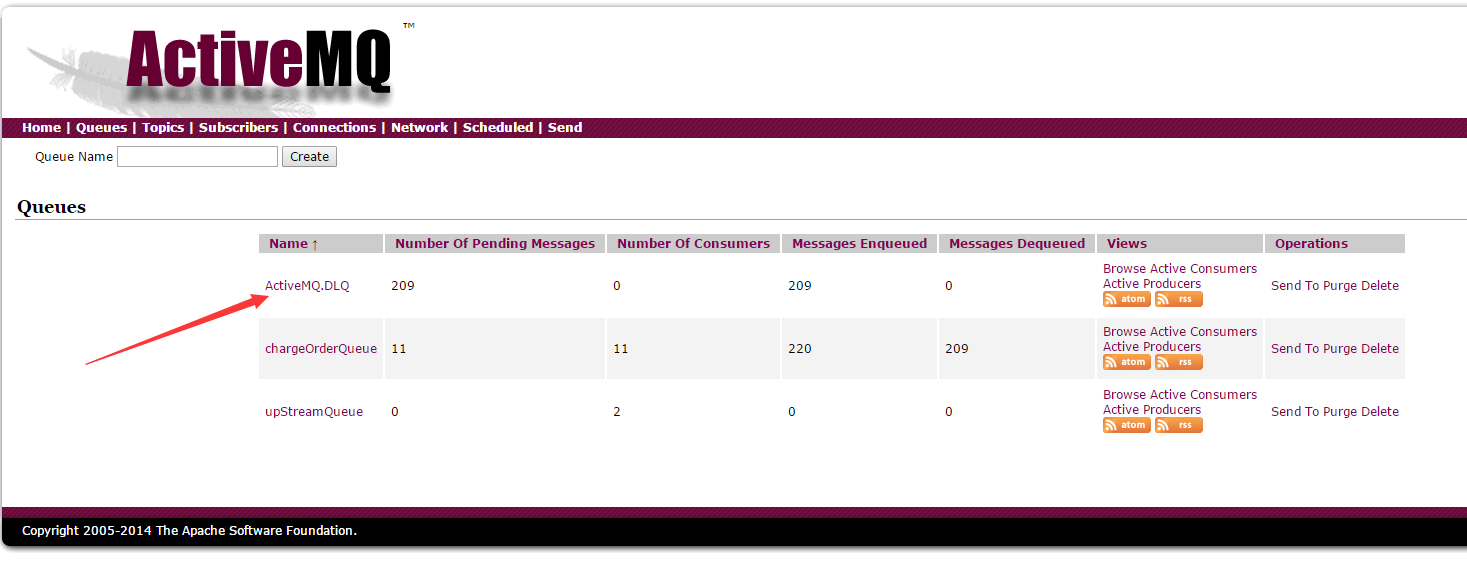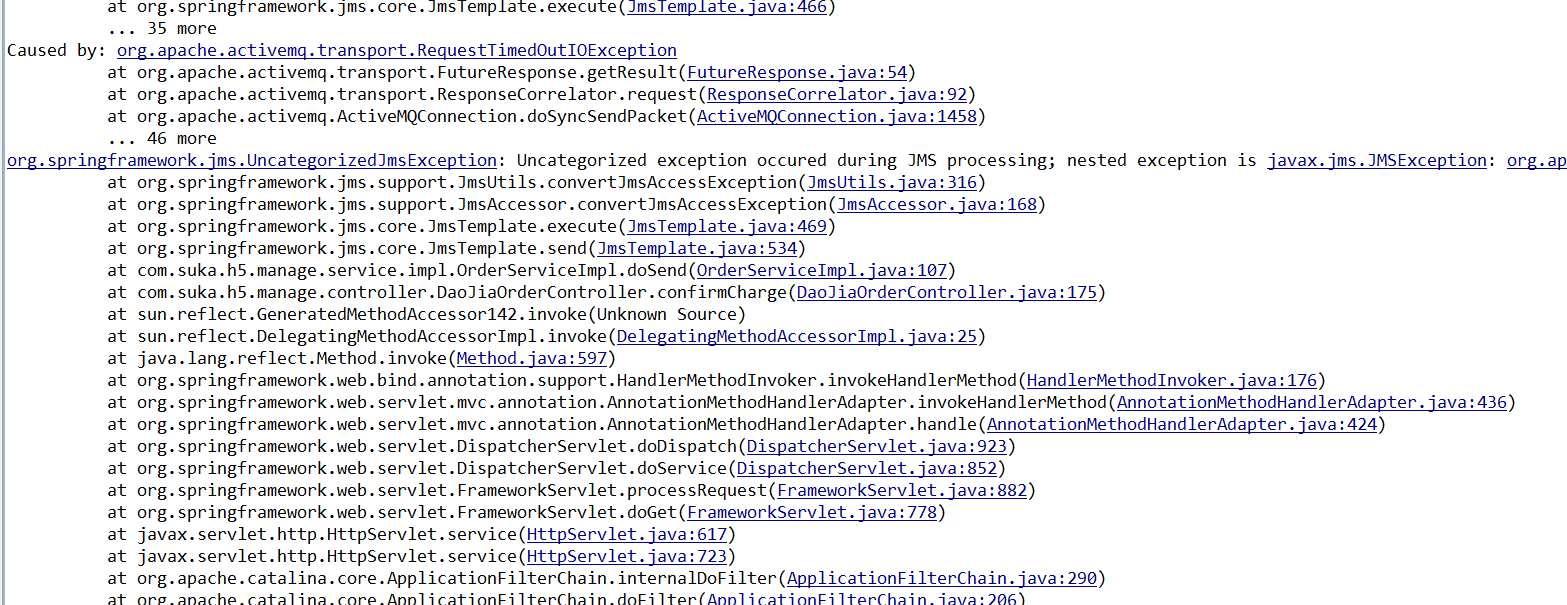ActiveMQ死信产生的原因及使用方案
DLQ-死信队列(Dead Letter Queue)用来保存处理失败或者过期的消息。
出现以下情况时,消息会被redelivered
A transacted session is used and rollback() is called(使用一个事务session,并且调用了rollback()方法).
A transacted session is closed before commit is called(一个事务session,关闭之前调用了commit).
A session is using CLIENT_ACKNOWLEDGE and Session.recover() is called(在session中使用CLIENT_ACKNOWLEDGE签收模式,并且调用了Session.recover()方法).
当一个消息被redelivered超过maximumRedeliveries(缺省为6次,具体设置请参考后面的内容)次数时,会给broker发送一个"Poison ack",这个消息被认为是a poison pill(毒丸),这时broker会将这个消息发送到DLQ,以便后续处理。
登录ActiveMQ管理端可以看到ActiveMq有一个默认的死信队:ActiveMQ.DLQ ,若未做设置则处理失败的消息会自动进入此队列。缺省持久消息过期,会被送到DLQ,非持久消息不会送到DLQ。本文将展示如何在Spring中引入私信重发机制。

一.死信的产生原因
1.死信队列堆积过多
测试的时候,每秒50条消息,堆积到3000 以上的时候,就会不定时地报错

因为每次连接MQ的时候,都创建了连接对象,占用内存太多,建议使用连接池,修改Spring 的配置
<bean id="amqConnectionFactory" class="org.apache.activemq.pool.PooledConnectionFactory">
<property name="connectionFactory">
<bean>
<property name="brokedURL" value="tcp://127.0.0.1:61616?jms.prefetchPolicy.all=2"></property>
<property name="sendTimeout" value="5000"></property>
<property name="closeTimeout" value="5000"></property>
<property name="useAsyncSend" value="true"></property>
<property name="useDedicatedTaskRunner" value="true"></property>
<property name="alwaysSessionAsync" value="true"></property>
</bean>
</property>
</bean>
2.网络故障::udp通信网络通信不正常会出现消息丢失,或挤压状况。
3.连接超时:ActiveMQ服务器挂了,要搭建集群,保证高可用。
二.Spring + ActiveMQ配置 死信队列(重发机制/延时发送)
1.ActiveMQ 部署时修改activemq.xml
在policyEntries节点中增加如下策略配置。
<policyEntry queue=">">
<deadLetterStrategy>
<individualDeadLetterStrategy queuePrefix="DLQ." useQueueForQueueMessages="true" processNonPersistent="true"/>
</deadLetterStrategy>
</policyEntry>
2.服务端spring-mq配置文件做如下配置
<?xml version="1.0" encoding="UTF-8"?>
<beans xmlns="http://www.springframework.org/schema/beans" xmlns:xsi="http://www.w3.org/2001/XMLSchema-instance"
xsi:schemaLocation="
http://www.springframework.org/schema/beans http://www.springframework.org/schema/beans/spring-beans-4.0.xsd"
default-lazy-init="true">
<!-- ActiveMQ 连接工厂 -->
<!-- 真正可以产生Connection的ConnectionFactory,由对应的 JMS服务厂商提供-->
<!--<amq:connectionFactory id="amqConnectionFactory"
brokerURL="${brokerUrl}" userName="${mq.userName}" password="${mq.password}" redeliveryPolicy="activeMQPolicy" />-->
<bean id="amqConnectionFactory" class="org.apache.activemq.ActiveMQConnectionFactory">
<property name="brokerURL" value="${brokerUrl}"></property>
<property name="userName" value="${mq.userName}"></property>
<property name="password" value="${mq.password}"></property>
<property name="redeliveryPolicy" ref="activeMQPolicy" /> <!-- 引用重发机制 -->
</bean>
<!-- 加入死信机制 -->
<bean id="activeMQPolicy" class="org.apache.activemq.RedeliveryPolicy">
<!--是否在每次尝试重新发送失败后,增长这个等待时间 -->
<property name="useExponentialBackOff" value="true"></property>
<!--重发次数,默认为6次 这里设置为1次 -->
<property name="maximumRedeliveries" value="1"></property>
<!--重发时间间隔,默认为1秒 -->
<property name="initialRedeliveryDelay" value="1000"></property>
<!--第一次失败后重新发送之前等待500毫秒,第二次失败再等待500 * 2毫秒,这里的2就是value -->
<property name="backOffMultiplier" value="2"></property>
<!--最大传送延迟,只在useExponentialBackOff为true时有效(V5.5),假设首次重连间隔为10ms,倍数为2,那么第
二次重连时间间隔为 20ms,第三次重连时间间隔为40ms,当重连时间间隔大的最大重连时间间隔时,以后每次重连时间间隔都为最大重连时间间隔。 -->
<property name="maximumRedeliveryDelay" value="1000"></property>
<!---->
<property name="destination" ref="allDestination"></property>
</bean>
<!-- Spring Caching连接工厂 -->
<!-- Spring用于管理真正的ConnectionFactory的ConnectionFactory -->
<bean id="connectionFactory" class="org.springframework.jms.connection.CachingConnectionFactory">
<!-- 目标ConnectionFactory对应真实的可以产生JMS Connection的ConnectionFactory -->
<property name="targetConnectionFactory" ref="amqConnectionFactory"></property>
<!-- 同上,同理 -->
<!-- <constructor-arg ref="amqConnectionFactory" /> -->
<!-- Session缓存数量 -->
<property name="sessionCacheSize" value="100"/>
</bean>
<!-- 定义Queue监听器 -->
<bean id="allDestination" class="org.apache.activemq.command.ActiveMQQueue">
<constructor-arg value="C2S.Q.TEST" />
</bean>
<bean id="listenerContainer" class="org.springframework.jms.listener.DefaultMessageListenerContainer">
<property name="connectionFactory" ref="connectionFactory" />
<property name="messageListener" ref="dataReceiver" /><!--dataReceiver为MQ处理类,根据实际情况配置-->
<property name="destination" ref="allDestination" />
<property name="sessionTransacted" value="true"/>
</bean>
3.服务端消息处理代码抛出 RuntimeExpection异常
catch (JMSException e) {
e.printStackTrace();
throw new RuntimeException("消息处理异常");
}
三. ActiveMQ配置死信队列(丢弃机制)
需求场景:
由于测试环境应用复杂的原因,造成了jms死信队列一直挤压很多数据,从而导致存储爆满,进而造成了各个客户端不能正常发送消息。针对这些死信队列,一般都没有利用价值的。
为了避免某队列的死信队列的挤压,而使整个jms不可用,我们选择了通过ActiveMQ的配置,直接丢弃掉死信队列的消息。缺省死信队列(Dead Letter Queue)叫做ActiveMQ.DLQ所有的未送达消息都会被发送到这个队列,以致会非常难于管理。
所以我们为了防止内存挤压导致mq不可用的情况发生,就需要对死信进行配置。可以通过配置文件(activemq.xml)来调整死信发送策略。
一些配置策略:
1. 不使用缺省的死信队列
缺省所有队列的死信消息都被发送到同一个缺省死信队列,不便于管理。可以通过individualDeadLetterStrategy或sharedDeadLetterStrategy策略来进行修改。如下:
<broker>
<destinationPolicy>
<policyMap>
<policyEntries>
<!— 设置所有队列,使用 '>' ,否则用队列名称 -->
<policyEntry queue=">">
<deadLetterStrategy>
<!--
queuePrefix:设置死信队列前缀
useQueueForQueueMessages: 设置使用队列保存死信,还可以设置useQueueForTopicMessages,使用Topic来保存死信
-->
<individualDeadLetterStrategy queuePrefix="DLQ." useQueueForQueueMessages="true" />
</deadLetterStrategy>
</policyEntry>
</policyEntries>
</policyMap>
</destinationPolicy>
...
</broker>
2. 非持久消息保存到死信队列
<policyEntry queue=">">
<deadLetterStrategy>
<sharedDeadLetterStrategy processNonPersistent="true" />
</deadLetterStrategy>
</policyEntry>
3. 过期消息不保存到死信队列
<policyEntry queue=">">
<deadLetterStrategy>
<sharedDeadLetterStrategy processExpired="false" />
</deadLetterStrategy>
</policyEntry>
4. 持久消息不保存到死信队列
对于过期的,可以通过processExpired属性来控制,对于redelivered的失败的消息,需要通过插件来实现如下:
1)丢弃所有死信
<beans>
<broker>
<plugins>
<discardingDLQBrokerPlugin dropAll="true" dropTemporaryTopics="true" dropTemporaryQueues="true" />
</plugins>
</broker>
</beans>
2)丢弃指定目的死信
<beans>
<broker ...>
<plugins>
<discardingDLQBrokerPlugin dropOnly="MY.EXAMPLE.TOPIC.29 MY.EXAMPLE.QUEUE.87" reportInterval="1000" />
</plugins>
</broker>
</beans>
注意,目的名称使用空格分隔
3)用正则表达式过滤丢弃消息
<beans>
<broker ...>
<plugins>
<discardingDLQBrokerPlugin dropOnly="MY.EXAMPLE.TOPIC.[0-9]{3} MY.EXAMPLE.QUEUE.[0-9]{3}" reportInterval="3000"/>
</plugins>
</broker>
</beans>
四.死信队列消息的属性
死信队列中的消息,会增加几个属性,比如原过期时间(originalExpiration),原originalDeliveryMode等。
五.死信队列解决方案总结
1.重发:对于安全性要求比较高的系统,那需要将发送失败的消息进行重试发
送,甚至在消息一直不能到达的情况下给予相关的邮件、短信等必要的告警
措施以保证消息的正确投递。
2.丢弃:在消息不是很重要以及有其他通知手段的 情况下,那么对消息做丢弃
处理也不失为一种好办法,毕竟如果大量不可抵达的消息存在于消息系统中
会对我们的系统造成非常大的负荷,所以我们也会采用丢弃的方式进行处理。
3.不管是 重发还是丢弃,都要根据实际的业务场景而定,不一而足,同学们在
实际中要具体问题具体分析。
参考:https://blog.csdn.net/qq_16055867/article/details/80443716
https://bbs.csdn.net/topics/392189838
https://blog.csdn.net/zhou2s_101216/article/details/78322080
https://blog.csdn.net/Leonardo9029/article/details/49513713
————————————————
版权声明:本文为CSDN博主「十步杀一人_千里不留行」的原创文章,遵循CC 4.0 BY-SA版权协议,转载请附上原文出处链接及本声明。
原文链接:https://blog.csdn.net/m0_37609579/article/details/82216332




【推荐】国内首个AI IDE,深度理解中文开发场景,立即下载体验Trae
【推荐】编程新体验,更懂你的AI,立即体验豆包MarsCode编程助手
【推荐】抖音旗下AI助手豆包,你的智能百科全书,全免费不限次数
【推荐】轻量又高性能的 SSH 工具 IShell:AI 加持,快人一步
· 分享一个免费、快速、无限量使用的满血 DeepSeek R1 模型,支持深度思考和联网搜索!
· 使用C#创建一个MCP客户端
· 基于 Docker 搭建 FRP 内网穿透开源项目(很简单哒)
· ollama系列1:轻松3步本地部署deepseek,普通电脑可用
· 按钮权限的设计及实现
2019-01-30 01-Angularjs开发环境搭建